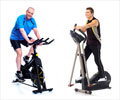
‘‘Both strength training and dynamic physical activities such as walking and cycling benefit the heart’.’
Tweet it Now
Researchers analyzed cardiovascular risk factors, such as high blood pressure, overweight, diabetes and high cholesterol, as a function of self-reported static and/or dynamic activity (strength training or walking/biking) in 4,086 American adults using data from the 2005-2006 National Health and Nutrition Examination Survey. The researchers then adjusted for age, ethnicity, gender and smoking and stratified by age: 21 to 44 years old or over 45 years old. In total, 36 percent of younger and 25 percent of older adults engaged in static activity, and 28 percent of younger and 21 percent of older adults engaged in dynamic activity. Researchers found engaging in either type of activity was associated with 30 to 70 percent lower rates of cardiovascular disease risk factors, but associations were strongest for static activity and in youth.
"One interesting takeaway was that both static and dynamic activity were almost as popular in older people as younger," Smith said. "I believe this gives clinicians the opportunity to counsel their older patients that they will fit into the gym or the road race just fine. The important thing is to make sure they are engaging in physical activity."
Smith said future research and data collection should use definitions of physical activity that separate static from dynamic activity to further investigate independent effects.
Advertisement













